GMC YUKON DENALI 2003 Owners Manual
Manufacturer: GMC, Model Year: 2003, Model line: YUKON DENALI, Model: GMC YUKON DENALI 2003Pages: 447, PDF Size: 21.97 MB
Page 171 of 447
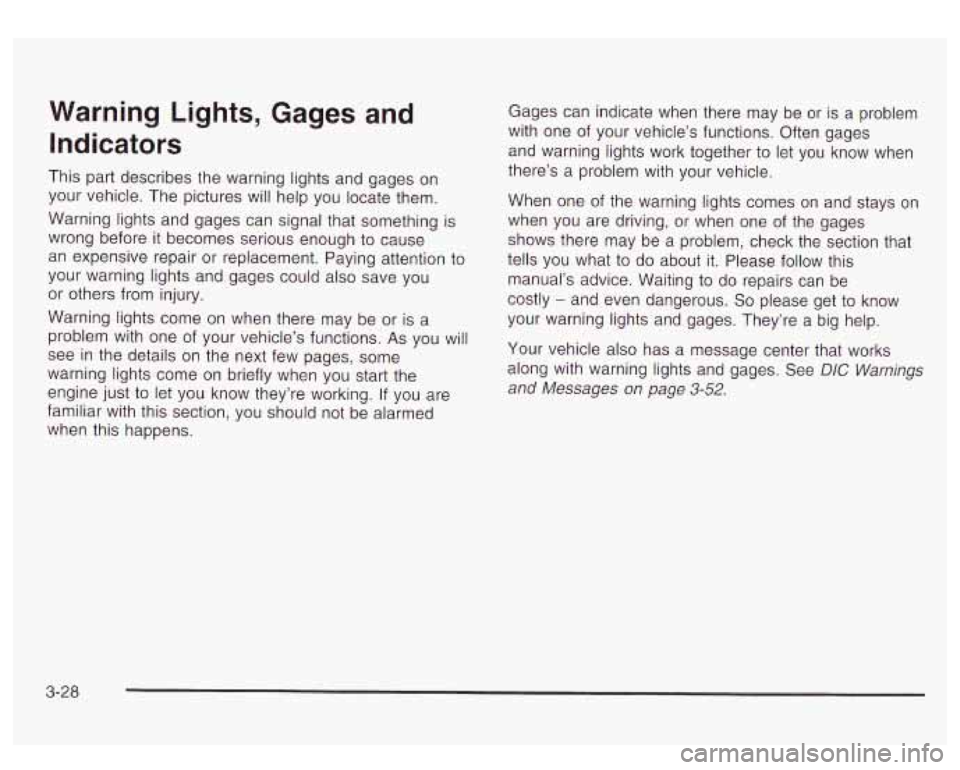
Warning Lights, Gages and
Indicators
This part describes the warning lights and gages on
your vehicle. The pictures will help you locate them.
Warning lights and gages can signal that something is
wrong before it becomes serious enough
to cause
an expensive repair or replacement. Paying attention
to
your warning lights and gages could also save you
or others from injury.
Warning lights come on when there may be or is a
problem with one of your vehicle’s functions.
As you will
see in the details on the next few pages, some
warning lights come on briefly when you start the
engine
just to let you know they’re working. If you are
familiar with this section, you should not be alarmed
when this happens. Gages can indicate
when there may be or
is a problem
with one of your vehicle’s functions. Often gages
and warning lights work together
to let you know when
there’s a problem with your vehicle.
When one of the warning lights comes on and stays on
when you are driving, or when one of the gages
shows there may be a problem, check the section that
tells you what to do about it. Please follow this
manual’s advice. Waiting to do repairs can be
costly
- and even dangerous. So please get to know
your warning lights and gages. They’re
a big help.
Your vehicle also has a message center that works
along with warning lights and gages. See
DIC Warnings
and Messages on page
3-52.
3-28
Page 172 of 447
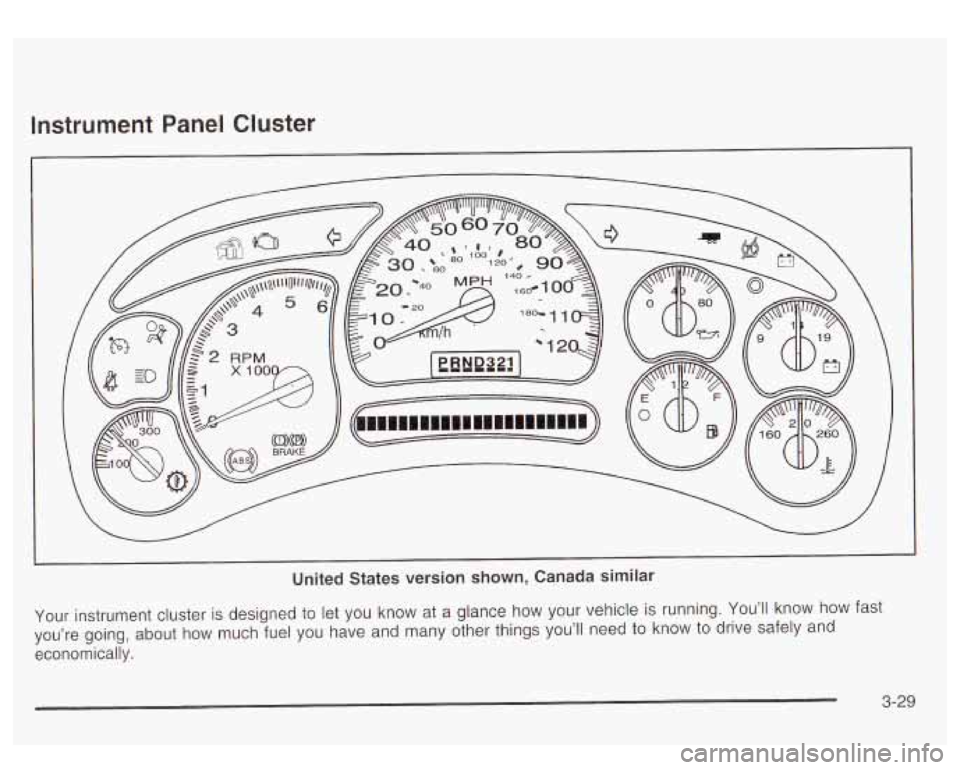
Y
Page 173 of 447
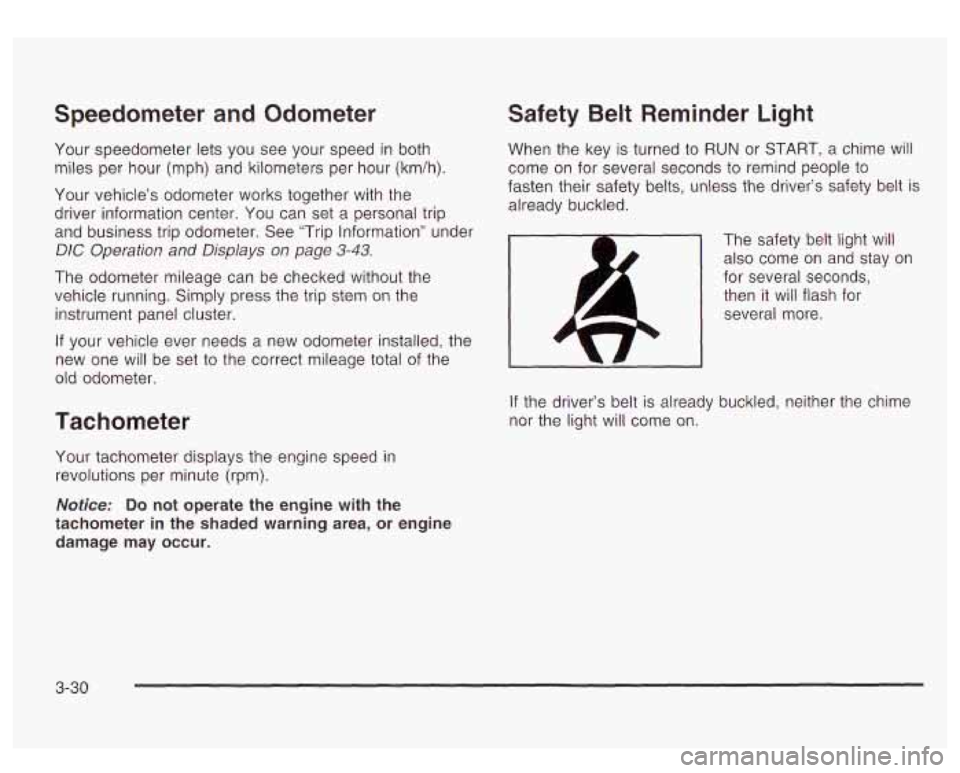
Speedometer and Odometer
Your speedometer lets you see your speed in both
miles per hour (mph) and kilometers per hour (km/h).
Your vehicle’s odometer works together with the driver information center. You can set
a personal trip
and business trip odometer. See “Trip Information” under
DIC Operation and Displays on page 3-43.
The odometer mileage can be checked without the
vehicle running. Simply press the trip stem
on the
instrument panel cluster.
If your vehicle ever needs a new odometer installed, the
new one will be set
to the correct mileage total of the
old odometer.
Tachometer
Your tachometer displays the engine speed in
revolutions per minute (rpm).
Safety Belt Reminder Light
When the key is turned to RUN or START, a chime will
come
on for several seconds to remind people to
fasten their safety belts, unless the driver’s safety belt is
already buckled.
The safety belt light will
also come on and stay on
for several seconds,
then it will flash for
several more.
If the driver’s belt is already buckled, neither the chime
nor the light will come
on.
Notice: Do not operate the engine with the
tachometer in the shaded warning area, or engine
damage may occur.
3-30
Page 174 of 447
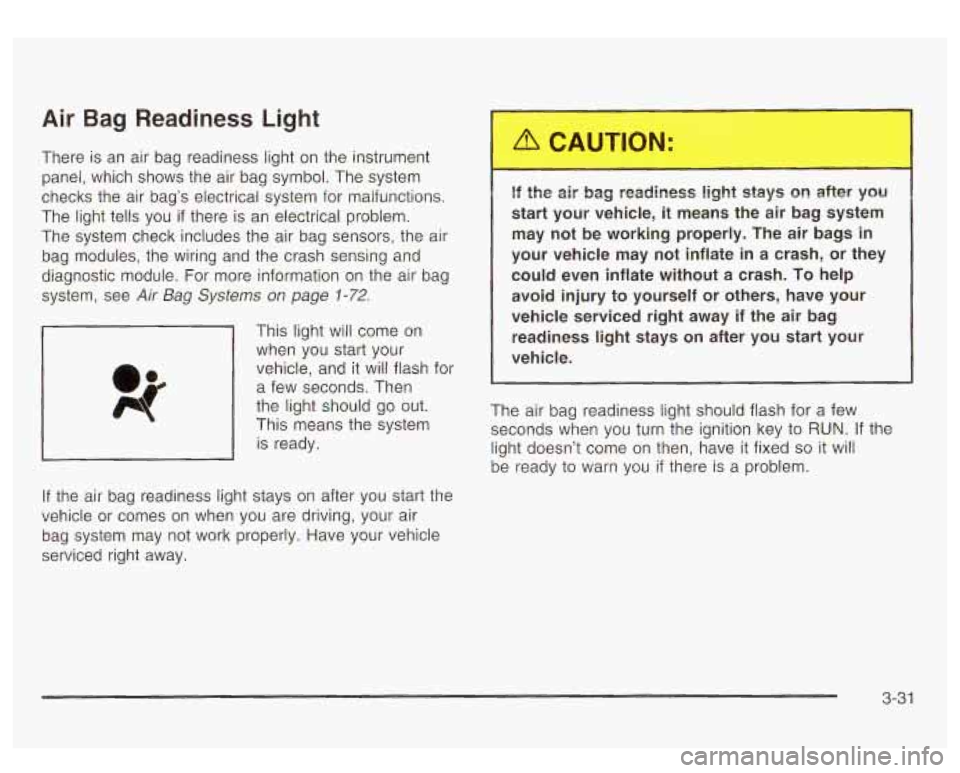
Air Bag Readiness Light
There is an air bag readiness light on the instrument
panel, which shows the air bag symbol. The system
checks the air bag’s electrical system for malfunctions.
The light tells you
if there is an electrical problem.
The system check includes the air bag sensors, the air
bag modules, the wiring and the crash sensing and
diagnostic module. For more information on the air bag
system, see
Air Bag Systems on page 1-72.
This light will come on
when you start your
vehicle, and it will flash for
a few seconds. Then
the light should go out.
This means the system
is ready.
If the air bag readiness light stays on after you start the
vehicle or comes on when you are driving, your air
bag system may not work properly. Have your vehicle
serviced right away.
16 the air bag readiness light stays on after yscl
start your vehicle,
it means the air bag system
may not be working properly. The air bags
in
your vehicle may not inflate in a crash, or they could even inflate without a crash.
To help
avoid injury to yourself or others, have your
vehicle serviced right away
if the air bag
readiness light stays on after you start your
vehicle.
The air bag readiness light should flash for a few
seconds when you turn the ignition key to RUN. If the
light doesn’t come on then, have it fixed
so it will
be ready to warn you
if there is a problem.
3-31
Page 175 of 447
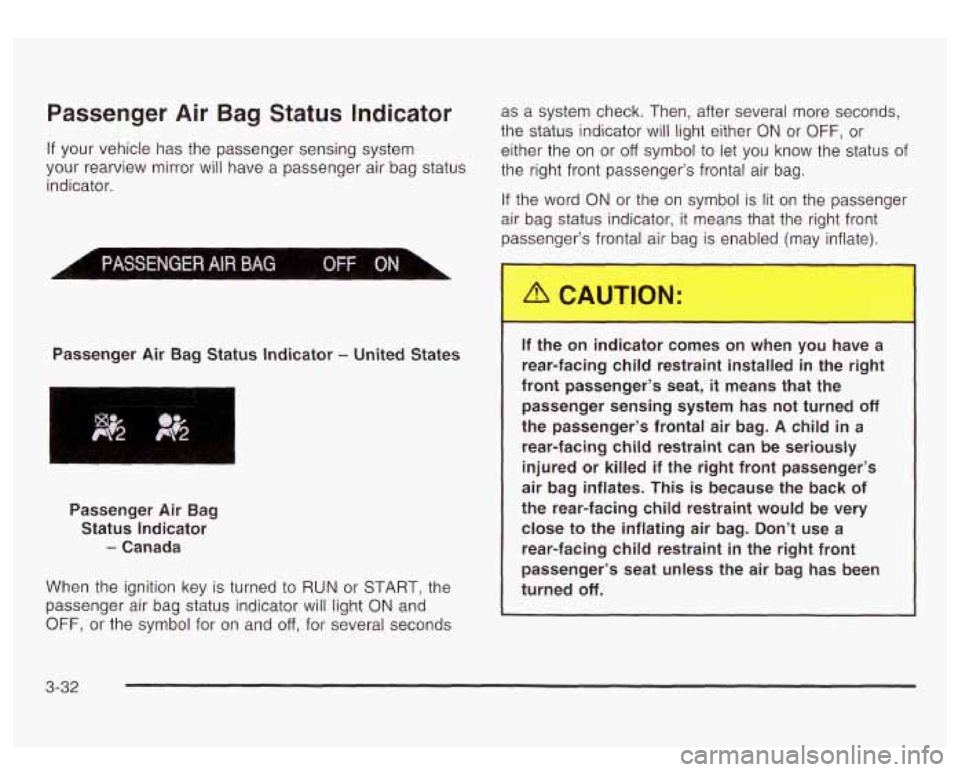
Passenger Air Bag Status Indicator as a system check. Then, after several more seconds,
the status indicator will light either
ON or OFF, or
If your vehicle has the passenger sensing system either the on or off symbol to let you know the status of
your rearview mirror Will have a passenger air bag status the right front passenger’s frontal air bag.
indicator.
Passenger Air Bag Status Indicator
- United States
If the word ON or the on symbol is lit on the passenger
air bag status indicator, it means that the right front
passenger’s frontal air bag is en, ed (may inflate).
Passenger Air Bag Status Indicator
- Canada
When the ignition key is turned
to RUN or START, the
passenger air bag status indicator will light
ON and
OFF, or the symbol for on and off, for several seconds
.. le on inc ator comes on when you have a
rear-facing child restraint installed in the right
front passenger’s seat,
it means that the
passenger sensing system has not turned
off
the passenger’s frontal air bag. A child in a
rear-facing child restraint can be seriously
injured or killed
if the right front passenger’s
air bag inflates. This is because the back of
the rear-facing child restraint would be very close to the inflating air bag. Don’t use a
rear-facing child restraint
in the right front
passenger’s seat unless the air bag has been
turned
off.
3-32
Page 176 of 447
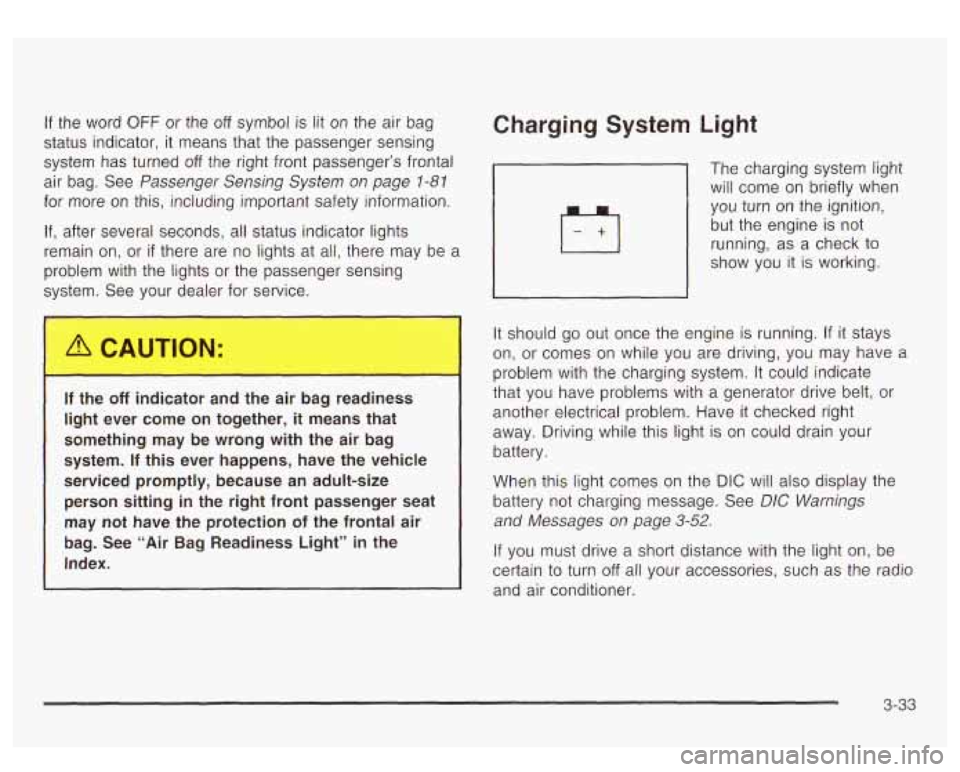
If the word OFF or the off symbol is lit on the air bag
status indicator,
it means that the passenger sensing
system has turned
off the right front passenger’s frontal
air bag. See Passenger Sensing System on page
7 -8 7
for more on this, including important safety information.
If, after several seconds, all status indicator lights
remain on, or
if there are no lights at all, there may be a
problem with the lights or the passenger sensing
system. See your dealer for service.
__ -he ofl ..jdicator and the air bag readiness
light ever come on together, it means that
something may be wrong with the air bag
system.
If this ever happens, have the vehicle
serviced promptly, because an adult-size
person sitting in the right front passenger seat
may not have the protection of the frontal air
bag. See “Air Bag Readiness Light” in the
Index.
Charging System Light
The charging system light
will come on briefly when you turn on the ignition,
but the engine is
not
running, as a check to
show you it
is working.
It should go out once the engine is running. If it stays
on, or comes on while you are driving, you may have a
problem with the charging system.
It could indicate
that you have problems with a generator drive belt, or
another electrical problem. Have it checked right
away. Driving while this light is on could drain your
battery.
When this light comes on the DIC will also display the
battery not charging message. See
DIC Warnings
and Messages
on page 3-52.
If you must drive a short distance with the light on, be
certain to turn
off all your accessories, such as the radio
and air conditioner.
3-33
Page 177 of 447
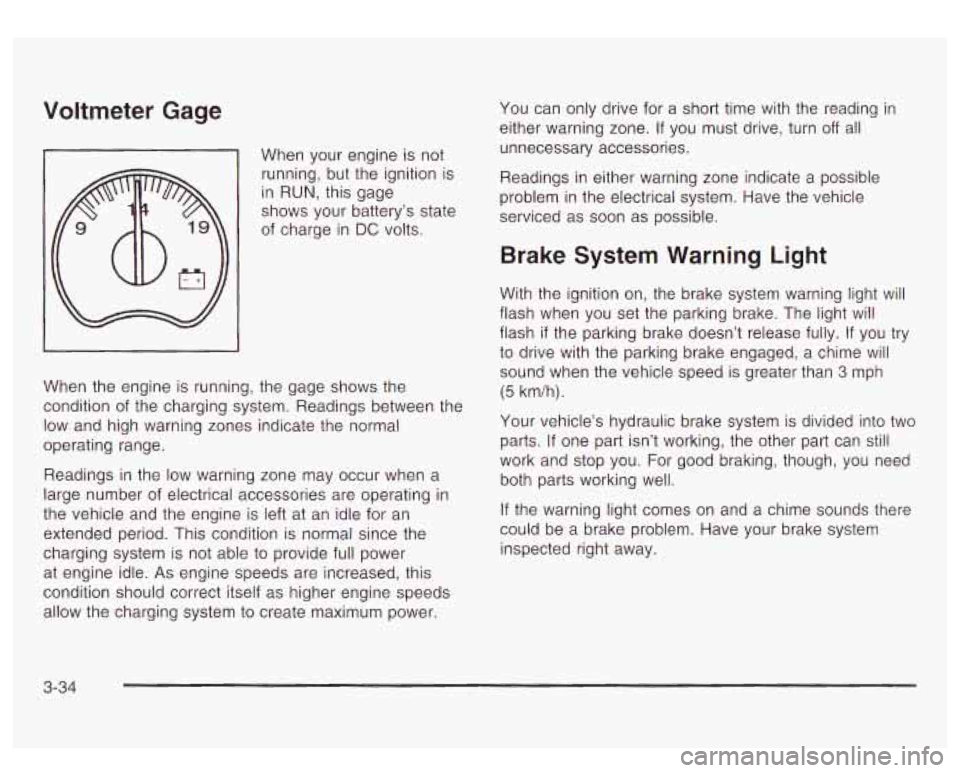
Voltmeter Gage
When your engine is not
running, but the ignition is
in
RUN, this gage
shows your battery’s state
of charge in
DC volts.
When the engine is running, the gage shows the
condition of the charging system. Readings between the
low and high warning zones indicate the normal
operating range.
Readings in the low warning zone may occur when a
large number of electrical accessories are operating in
the vehicle and the engine is left at an idle for an
extended period. This condition is normal since the
charging system is not able
to provide full power
at engine idle.
As engine speeds are increased, this
condition should correct itself as higher engine speeds allow the charging system
to create maximum power. You
can only drive for a short time with the reading in
either warning zone. If you must drive, turn
off all
unnecessary accessories.
Readings in either warning zone indicate a possible
problem in the electrical system. Have the vehicle
serviced as soon as possible.
Brake System Warning Light
With the ignition on, the brake system warning light will
flash when you set the parking brake. The light will
flash
if the parking brake doesn’t release fully. If you try
to drive with the parking brake engaged, a chime will
sound when the vehicle speed is greater than 3 mph
(5 km/h).
Your vehicle’s hydraulic brake system
is divided into two
parts. If one part isn’t working, the other part can still
work and stop you. For good braking, though, you need
both parts working well.
If the warning light comes on and a chime sounds there
could be a brake problem. Have your brake system
inspected right away.
3-34
Page 178 of 447
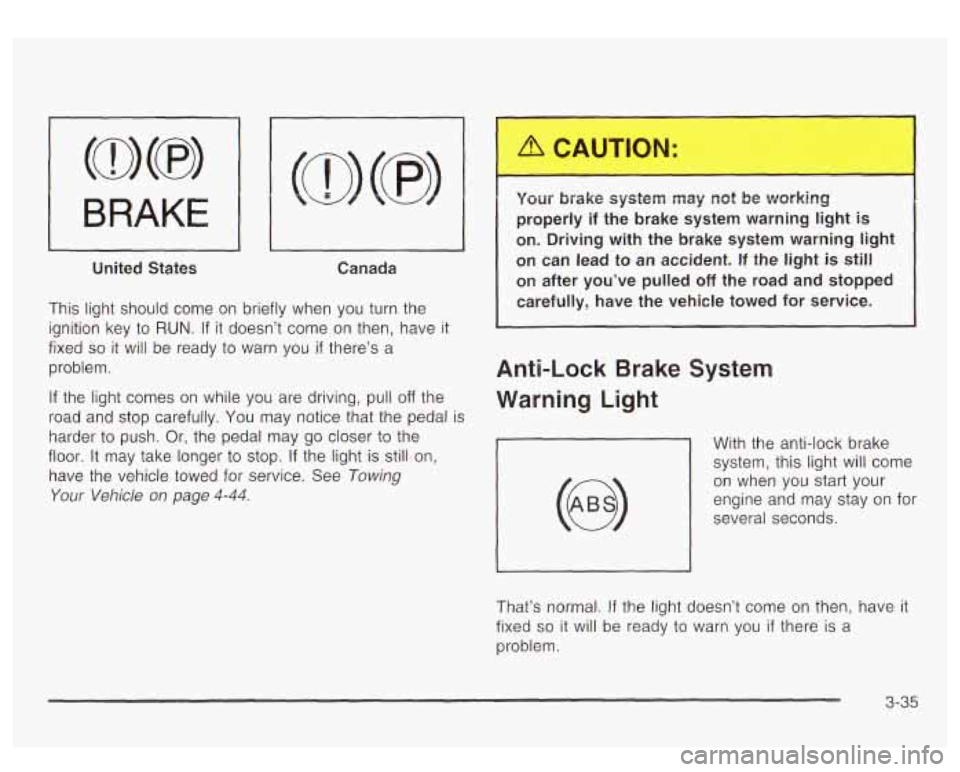
w,
United States Canada
This light should come on briefly when you turn the
ignition key to
RUN. If it doesn’t come on then, have it
fixed
so it will be ready to warn you if there’s a
problem.
If the light comes on while you are driving, pull off the
road and stop carefully. You may notice that the pedal
is
harder to push. Or, the pedal may go closer to the
floor.
It may take longer to stop. If the light is still on,
have
the vehicle towed for service. See Towing
Your Vehicle on page 4-44.
Your brake system may not be working
properly
if the brake system warning light is
on. Driving with the brake system warning light
on can lead to an accident.
If the light is still
on after you’ve pulled off the road and stopped
carefully, have the vehicle towed for service.
Anti-Lock Brake System
Warning Light
With the anti-lock brake
system, this light will come
on when you start your
engine and may stay on for
several seconds.
That’s normal. If the light doesn’t come on then, have
it
fixed so it will be ready to warn you if there is a
problem.
3-35
Page 179 of 447
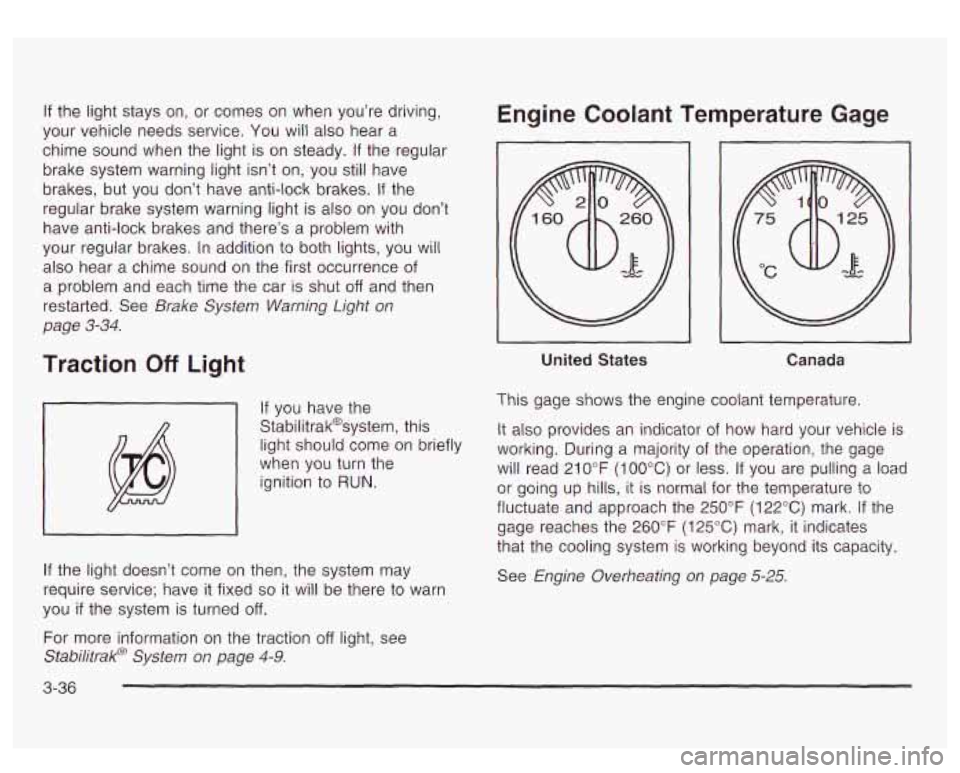
If the light stays on, or comes on when you’re driving,
your vehicle needs service. You will also hear a
chime sound when the light is on steady.
If the regular
brake system warning light isn’t on, you still have
brakes, but you don’t have anti-lock brakes.
If the
regular brake system warning light is also on you don’t
have anti-lock brakes and there’s a problem with
your regular brakes. In addition to both lights, you will
also hear a chime sound on the first occurrence of
a problem and each time the car is shut off and then
restarted. See Brake System Warning Light on
page
3-34.
Traction Off Light
If you have the
Stabilitrak@system, this
light should come on briefly
when you turn the
ignition to
RUN.
If the light doesn’t come on then, the system may
require service; have it fixed
so it will be there to warn
you
if the system is turned off.
For more information on the traction off light, see
Stabilitrak@
System on page 4-9.
3-36
Engine Coolant Temperature Gage
~~ ~
United States
I I
Canada
This gage shows the engine coolant temperature.
It also provides an indicator
of how hard your vehicle is
working. During a majority of the operation, the gage
will read 21
0°F (100°C) or less. If you are pulling a load
or going up hills, it is normal for the temperature to
fluctuate and approach the 250°F (122°C) mark.
If the
gage reaches the 260°F
(125°C) mark, it indicates
that the cooling system
is working beyond its capacity.
See Engine Overheating on page
5-25.
Page 180 of 447
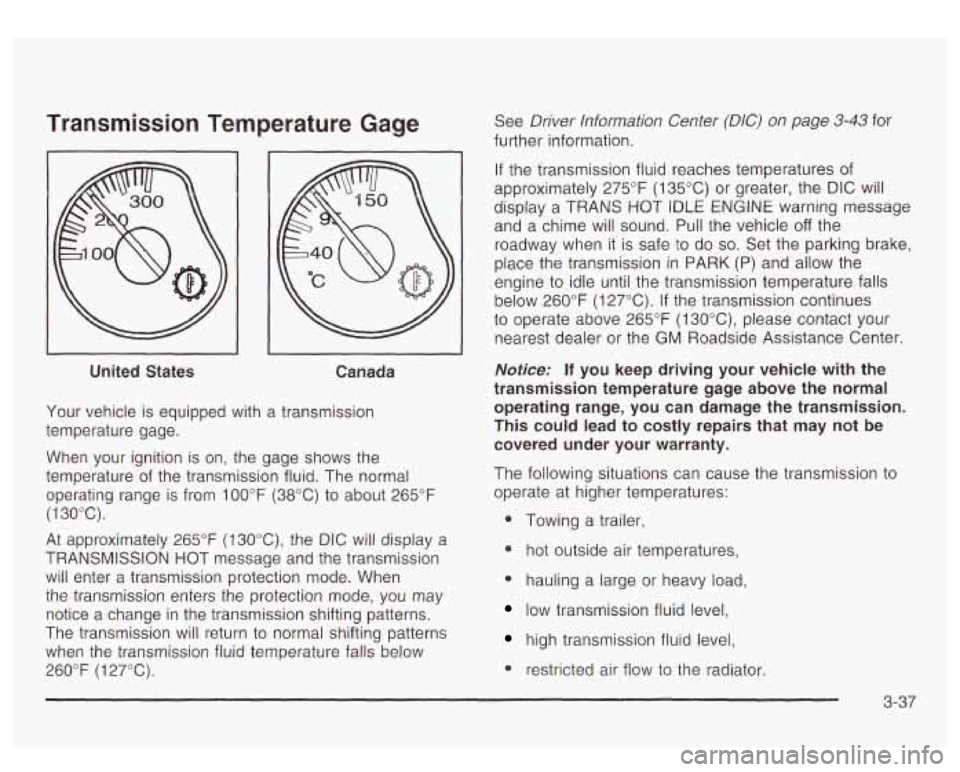
Transmission Temperature Gage
--
United States Canada
Your vehicle is equipped with a transmission
temperature gage.
When your ignition is on, the gage shows the
temperature of the transmission fluid. The normal
operating range is from
100°F (38°C) to about 265°F
(1 30°C).
At approximately 265°F (130°C), the DIC will display a
TRANSMISSION HOT message and the transmission
will enter a transmission protection mode. When
the transmission enters the protection mode, you may
notice a change in the transmission shifting patterns.
The transmission will return to normal shifting patterns
when the transmission fluid temperature falls below
260°F
(1 27°C). See
Driver Information
Center (DIC) on page 3-43 for
further information.
If the transmission fluid reaches temperatures of
approximately 275°F (135°C) or greater, the DIC will
display a TRANS
HOT tDLE ENGtNE warning message
and a chime will sound. Pull the vehicle
off the
roadway when it is safe
to do so. Set the parking brake,
place the transmission in PARK
(P) and allow the
engine to idle until the transmission temperature falls
below 260°F (127°C).
If the transmission continues
to operate above 265°F
(1 30"C), please contact your
nearest dealer or the
GM Roadside Assistance Center.
Notice: If you keep driving your vehicle with the
transmission temperature gage above the normal
operating range, you can damage the transmission.
This could lead to costly repairs that may not be
covered under your warranty.
The following situations can cause the transmission to
operate at higher temperatures:
0 Towing a trailer,
* hot outside air temperatures,
0 hauling a large or heavy load,
low transmission fluid level,
high transmission fluid level,
0 restricted air flow to the radiator.